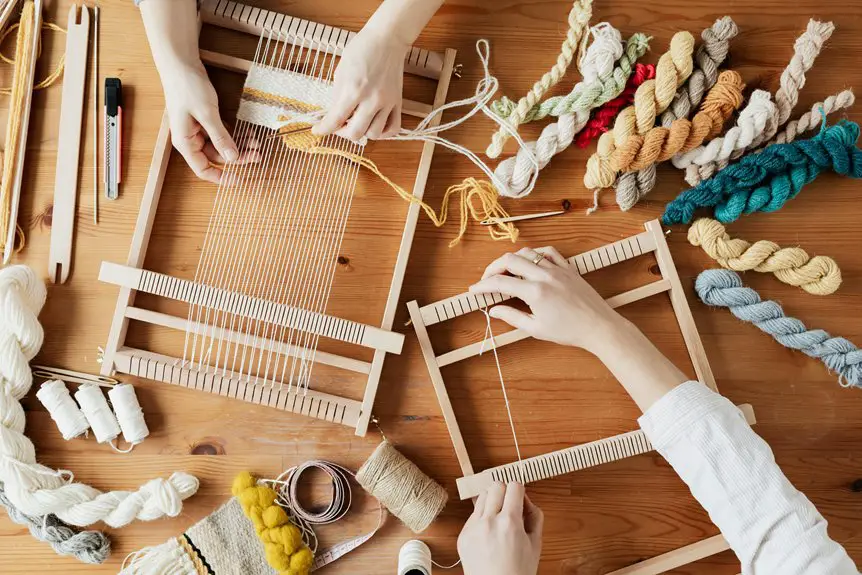Cotton casement fabric is a durable, breathable cotton material with a plain weave that gives it strength and a soft texture. You’ll find it perfect for home décor like curtains and cushion covers, as it filters light while maintaining shape and comfort. It’s easy to clean and holds vibrant colors well, making it great for everyday use. If you want to explore its unique weave, care tips, and comparisons to other cotton fabrics, there’s plenty more to discover.
Table of Contents
Key Takeaways
- Cotton casement fabric is a lightweight, durable, and breathable woven material made from pure cotton fibers.
- It features a plain weave structure that offers strength, flexibility, and resistance to everyday wear and tear.
- The fabric is commonly used for curtains and drapes, providing a soft look while filtering natural light.
- It is suitable for upholstery, slipcovers, and cushion covers due to its durability and ease of cleaning.
- Cotton casement fabric has a matte finish and textured feel, adding cozy elegance to home décor.
Definition and Origin of Cotton Casement Fabric
Cotton casement fabric is a lightweight, woven material known for its durability and breathability. You’ll find it made from pure cotton fibers, giving it a soft feel while still holding up well over time.
Originating centuries ago, casement fabric was initially crafted for window treatments like curtains and drapes, valued for its ability to let light in without sacrificing privacy. When you use cotton casement, you’re working with a fabric that balances strength and comfort, making it ideal for various home applications.
Its natural fibers allow air to pass through easily, helping maintain a fresh environment. Whether you’re sewing or designing, understanding this fabric’s background helps you appreciate its practical qualities and timeless appeal.
Weaving Techniques Behind Cotton Casement
You’ll notice cotton casement fabric uses a simple plain weave structure that balances strength and breathability.
The type of yarn chosen plays a big role in its texture and feel.
Understanding these factors will help you appreciate the fabric’s durability and why it’s so popular.
Plain Weave Structure
The plain weave structure forms the foundation of cotton casement fabric, creating its distinctive strength and durability.
When you look closely, you’ll see that the threads interlace in a simple over-and-under pattern. This straightforward method guarantees the fabric remains tightly woven yet flexible, giving you a balanced texture that’s neither too heavy nor too light.
You’ll appreciate how this weave enhances the fabric’s resistance to wear and tear, making it ideal for everyday use. The uniformity of the plain weave also allows the fabric to drape smoothly, which is why it’s popular in home furnishings and apparel.
Yarn Types Used
Different yarn types play an essential role in shaping the texture and quality of casement fabric.
When you choose cotton casement, you’ll often find it made with fine, tightly spun yarns that give the fabric a smooth and crisp finish. The yarns can vary from combed cotton, which is softer and more uniform, to carded cotton, offering a slightly rougher texture.
Sometimes, manufacturers use mercerized cotton yarns, which enhance luster and strength, making the fabric more vibrant and durable.
You’ll also encounter varying yarn thicknesses—finer yarns create a lightweight, delicate fabric, while thicker yarns result in a heavier, more substantial feel.
Understanding these yarn differences helps you pick the right casement fabric to match your specific aesthetic and functional needs.
Fabric Durability Factors
Fine yarns create a smooth texture, but how the threads are woven together greatly impacts the fabric’s strength and lifespan.
When you choose cotton casement fabric, the weaving technique plays an essential role in durability. A tight plain weave, where warp and weft threads cross evenly, gives the fabric a sturdy structure that resists tearing and wear.
You’ll also notice that the thread count affects toughness—the higher the count, the denser and more durable the fabric becomes.
Additionally, how the fabric is finished, such as through mercerization or calendaring, can enhance strength and resistance to shrinking.
Key Physical Properties of Cotton Casement
You’ll notice that cotton casement fabric has a unique texture and tight weave that give it strength and smoothness.
Its durability stands up well to regular use, while the breathable fibers keep you comfortable.
Let’s explore how these physical properties make cotton casement ideal for various applications.
Texture and Weave
The texture and weave of cotton casement fabric give it a unique character that suits various uses. When you touch it, you’ll notice a smooth yet sturdy feel, thanks to its plain weave structure.
This weave method interlaces threads evenly, creating a balanced surface that isn’t too coarse or too soft. You’ll appreciate how this texture allows the fabric to drape nicely while maintaining form.
The tight weave also results in a fine, uniform appearance, making it ideal for tailored applications like curtains and upholstery. Plus, the subtle texture adds aesthetic appeal without overwhelming other design elements.
When working with cotton casement, you’ll find its texture and weave provide versatility, combining visual interest with practical handling.
Durability and Breathability
Along with its appealing texture and balanced weave, cotton casement fabric stands out for its durability and breathability.
When you choose this fabric, you’re getting a material that withstands regular use without losing shape or strength. Its tight yet open weave offers excellent airflow, keeping you cool and comfortable.
You won’t have to worry about overheating or excessive moisture buildup, making it ideal for clothing, curtains, and upholstery. Plus, cotton’s natural fibers resist wear and tear better than many synthetic alternatives.
Benefits of Using Cotton Casement Fabric
Because cotton casement fabric combines durability with breathability, you’ll find it ideal for various applications around your home.
It’s easy to clean and maintain, saving you time and effort. The natural fibers resist wear and tear, ensuring your fabric lasts longer without losing its shape or texture.
You’ll appreciate its versatility—cotton casement fabric adapts well to different climates, keeping you comfortable whether it’s warm or cool.
It also holds dye beautifully, so colors stay vibrant and fade-resistant over time. Plus, its soft yet sturdy feel provides excellent comfort without sacrificing strength.
Choosing cotton casement fabric means opting for an eco-friendly, sustainable material that supports healthier indoor air quality due to its breathability and natural composition.
Cotton Casement in Home Décor Applications
You’ll find cotton casement fabric enhances your home décor in many stylish and practical ways. Its durability and natural texture make it perfect for curtains, giving windows a soft, inviting look while filtering light gently.
You can also use it for slipcovers or cushion covers, where its breathable quality keeps seating comfortable. Since cotton casement holds dye well, you can find or create vibrant patterns that match your interior theme.
It’s easy to clean, so it’s ideal for high-traffic areas or homes with kids and pets. Plus, its matte finish lends a cozy, understated elegance that complements rustic, modern, or traditional décor alike.
Incorporating cotton casement fabric helps you achieve a balanced mix of comfort and style throughout your living spaces.
Fashion Uses for Cotton Casement Fabric
When you choose cotton casement fabric for your wardrobe, you get a blend of comfort and durability that’s hard to beat. This lightweight, breathable material works perfectly for casual shirts, blouses, and summer dresses, keeping you cool while maintaining structure.
You can also rely on it for tailored pieces like skirts and light jackets because it holds its shape well without feeling stiff. Its natural texture adds subtle visual interest, making simple designs stand out.
Plus, cotton casement’s easy dyeing process means you’ll find it in a wide array of colors and patterns to suit your style. Whether you’re sewing at home or shopping ready-made, cotton casement fabric offers versatility that fits effortlessly into your everyday fashion choices.
Care and Maintenance Tips for Cotton Casement
Maintaining the quality of your cotton casement fabric is easier than you might think. Always wash it in cold water using a gentle cycle to prevent shrinkage and preserve its texture. Avoid harsh detergents; mild soap works best.
When drying, skip the high heat—opt for air drying or tumble dry on low to maintain softness and reduce wrinkles. Iron your fabric while it’s slightly damp, using a medium heat setting to smooth out any creases.
Store cotton casement fabric in a cool, dry place away from direct sunlight to prevent fading. If you notice stains, treat them promptly with a mild stain remover.
Comparing Cotton Casement to Other Cotton Fabrics
Although cotton casement shares many qualities with other cotton fabrics, it stands out in texture and durability. When you compare it to other cotton types, you’ll notice its unique weave offers a slightly rougher feel but greater strength.
Here’s how it stacks up:
- Cotton Voile: Lightweight, sheer, and soft—great for airy curtains but less robust.
- Cotton Twill: Heavier with diagonal ribs, excellent for durable clothing but less breathable.
- Cotton Lawn: Smooth and crisp, ideal for fine shirts but not as sturdy.
- Cotton Canvas: Thick and rugged, perfect for bags but lacks the delicate weave of casement.
You’ll find cotton casement is your go-to when you want a balance of durability and a textured finish for home décor.
Frequently Asked Questions
Can Cotton Casement Fabric Be Used for Outdoor Furniture?
You shouldn’t use cotton casement fabric for outdoor furniture since it isn’t water-resistant or UV-protected. Instead, opt for specially treated outdoor fabrics that can withstand weather and sun exposure to keep your furniture looking great longer.
Is Cotton Casement Fabric Hypoallergenic?
You might worry about allergies, but cotton casement fabric is naturally hypoallergenic, so it won’t irritate your skin. You’ll enjoy its breathability and softness without sneezing or discomfort, making it perfect for sensitive users.
How Does Cotton Casement Fabric React to Dyeing?
You’ll find cotton casement fabric absorbs dye well, giving vibrant, even colors. Since it’s natural fiber, it reacts predictably to most dyes, but you’ll want to pre-wash to avoid uneven shades or shrinking afterward.
Are There Eco-Friendly Alternatives to Cotton Casement Fabric?
Imagine soft, breathable fabrics like hemp or organic linen swaying gently in the breeze. You’ll find these eco-friendly alternatives to cotton casement fabric not only sustainable but also durable, perfect for your green-conscious projects.
What Is the Average Cost per Yard of Cotton Casement Fabric?
You’ll find cotton casement fabric usually costs between $8 and $15 per yard, depending on quality and retailer. If you shop around, you’ll often get better deals or discounts on bulk purchases.
- The Use of Nonwovens in Construction and Civil Engineering - July 11, 2025
- The Use of Nonwovens in Construction and Civil Engineering - July 11, 2025
- The Use of Nonwovens in Construction and Civil Engineering - July 11, 2025







